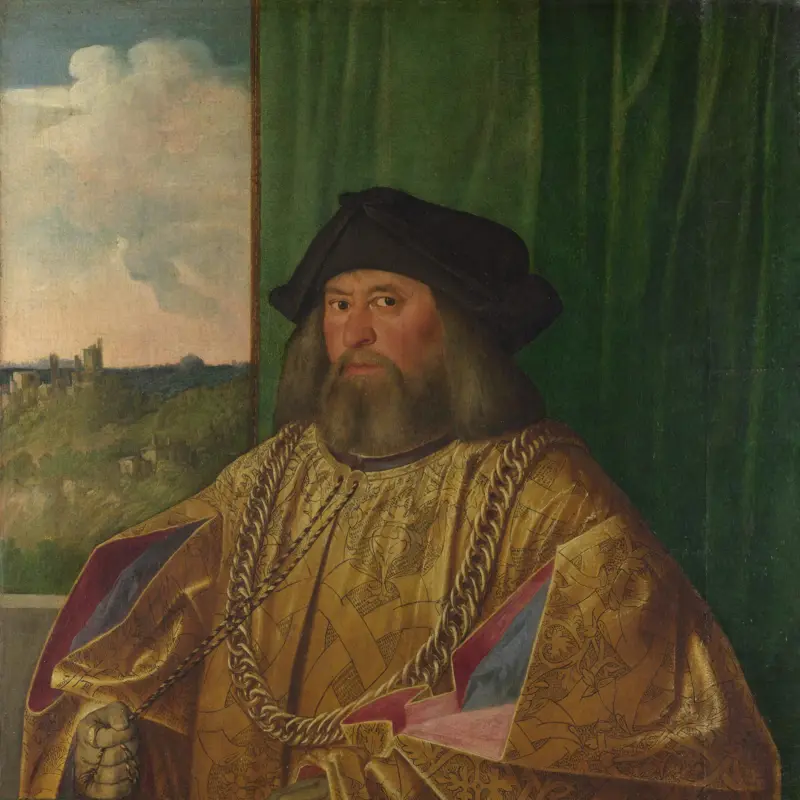Possibly by Giovanni Cariani, 'The Holy Family with Saints and a Donor', about 1540
About the work
Overview
An unidentified woman and boy kneel in prayer before the Virgin and Child with saints in a landscape. Saint Lucy, the bearer of light, holds a martyr’s palm and a burning oil lamp. The woman, wearing an ornamented dress and cloak, is probably the mother of the kneeling boy presented by Saint Joseph. The flowering rod Saint Joseph holds represents the staff that broke into blossom to show he was chosen to marry the Virgin Mary.
The light around the woman’s head suggests she is supposed to be a saint, but it may not be original. The mother and son are probably the donors of the painting.
This picture is possibly by Cariani although it is not entirely typical of his work. The composition is derived from Camillo Boccaccino’s altarpiece in Cremona Cathedral, commissioned in 1533, showing the Virgin and Child with Saints Martha, Mary Magdalene, James and Anthony Abbot, which is now lost.
Key facts
Details
- Full title
- The Virgin and Child with Saints Joseph and Lucy and a Woman and Boy at Prayer
- Artist
- Possibly by Giovanni Cariani
- Artist dates
- about 1487 - 1547
- Date made
- about 1540
- Medium and support
- oil on canvas
- Dimensions
- 85.8 × 118 cm
- Acquisition credit
- Bought, 1886
- Inventory number
- NG1203
- Location
- Not on display
- Collection
- Main Collection
Provenance
The regular journeys to Italy undertaken by both Eastlake and Boxall had been suspended by 1885, when John Lucas Walker bequeathed £10,000 to be spent on acquisitions. The Director, Frederic Burton, proposed to the Board of Trustees that this bequest would be best spent in Italy and sought authority from the Treasury for an official journey. Between 9 October and 13 November he visited Venice, Milan and Turin. On 14 December Burton informed the Board that he had purchased two pictures from Baslini in Milan: a Florentine Quattrocento tondo (NG 1199) and two panels from a polyptych then attributed to Macrino d’Alba, now to ‘Style of Defendente Ferrari’ (NG 1200 and 1201). He also announced that he had made overtures towards purchasing two pictures from the ‘heirs of the late Sig. Andreossi’: a Holy Family by Bonifazio de’ Pitati (for £720) and a Holy Family by Pordenone (for £420). The purchase of the pictures at these prices was then announced to the Board on 1 February 1886, but with the attribution to Pordenone now changed to Cariani. A letter from Burton to George Howard, written from Venice on 25 October 1885, mentions that he is in treaty for a ‘particularly good Cariani’, so the attribution was not a new one. The Bonifazio is NG 1202. A letter from Milan, signed by Francesco Damiano on behalf of the Andreossi firm and dated 16 February 1886, acknowledged receipt of payment for the two paintings, which was given as 28,500 lire. It was not an impressive haul, and one wonders whether the Trustees regretted licensing Burton to take this initiative.
It seems likely that Morelli played some part in this transaction, perhaps recommending the two Andreossi pictures to Burton, since he writes to Jean Paul Richter in a letter of 28 January 1886 that he has received ‘ein äusserst freundlicher Brief’ from Burton reporting the arrival of the two pictures in London (in a later letter, dated 1 July, Richter regretted the glass that had been placed over them).
The Andreossi family, originally from San Maurezzan in Switzerland, were involved in the silk industry and resided in both Bergamo and Milan – Enrico Andreossi was a cousin of Giovanni Morelli, whose chief address was in Via Clerici in Milan. A Previtali in the Casa Andreossi was noted by Cavalcaselle and this is known to have been bought for him by Morelli; Adriano Andreossi bequeathed a portrait (school of Moroni) to the Accademia Carrara in 1902, and a Maurizio Andreossi sold a Bergognone to the Brera in 1898. There is no evidence as to the origin of NG 1203, but Enrico Andreossi’s collection seems to have been formed relatively recently (the Bonifazio, at any rate, was noted by Cavalcaselle in 1871 as coming from the Terzi Collection). As we have noted, Morelli helped to form Andreossi’s collection, but Morelli’s attribution of NG 1203 to Cariani seems to date from immediately before the picture’s acquisition – NG 1203 was in any case, as we have noted, first mentioned by Burton as a work by Pordenone – and in proposing Bonifazio as the artist of NG 1202 Morelli noted that this owner had exhibited it as a Palma.
Additional information
Text extracted from the ‘Provenance’ section of the catalogue entry in Nicholas Penny, ‘National Gallery Catalogues: The Sixteenth Century Italian Paintings’, vol. 1, ‘Paintings from Bergamo, Brescia and Cremona’, London 2004; for further information, see the full catalogue entry.
Bibliography
-
1959Gould, Cecil, National Gallery Catalogues: The Sixteenth Century Venetian School, London 1959
-
1987Gould, Cecil, National Gallery Catalogues: The Sixteenth Century Italian Schools, London 1987
-
2001
C. Baker and T. Henry, The National Gallery: Complete Illustrated Catalogue, London 2001
-
2004
Penny, Nicholas, National Gallery Catalogues: The Sixteenth Century Italian Paintings, 1, Paintings from Bergamo, Brescia and Cremona, London 2004
About this record
If you know more about this work or have spotted an error, please contact us. Please note that exhibition histories are listed from 2009 onwards. Bibliographies may not be complete; more comprehensive information is available in the National Gallery Library.

